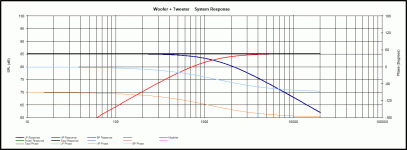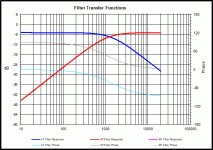Capacitors limit low frequencies, thats why we use them as high pass as CR.…and not resistors?
That is, why don’t passive x-overs use RC and CR filters, instead of LC and CL?
(And yes I know that speaker impedance is normally used in a CR configuration for high-pass filters, but my question is on a more theoretical level, just out of curiousity.)
Inductors limit high frequencies, thats why we use them as low pass filters as LR.
Resistors load the circuit, no frequency limit. From zero to infinity. They itself do not present high or low pass filter. Only in combination with C or L.
Hence you can not substitute L with R.
Ps: i have seen 2way crossovers where cap to tweeter was omitted and resistor in parallel served as filter. But such instances are rare.
To some degree true.Capacitors limit low frequencies, thats why we use them as high pass as CR.
Inductors limit high frequencies, thats why we use them as low pass filters as LR.
Resistors load the circuit, no frequency limit. From zero to infinity. They itself do not present high or low pass filter. Only in combination with C or L.
Hence you can not substitute L with R.
You can use RC as a low pass. Common in electronics.
You can use LC as a high pass.
You can even make a LC CL bandpass etc.
There are many ways to make a filter, and they have different ideal uses.
Not all are suited for loudspeakers though.
So here’s the follow-up question then. When building low-power passive EQs (within the amp or preamp stages etc), would it be better to use LC-CL as well rather than RC-CR? In order to take some load off of the signal chain?
It may save you using a gain stage, but have you worked out a value and secured a part and measured it's useful band in an equivalent circuit?
https://www.diyaudio.com/community/threads/why-do-crossovers-use-inductors.404997/#post-7496370So here’s the follow-up question then. When building low-power passive EQs (within the amp or preamp stages etc), would it be better to use LC-CL as well rather than RC-CR? In order to take some load off of the signal chain?
Again, without the combination of L, C (as well as R), no control over Q-factor.
https://en.wikipedia.org/wiki/Q_factor
https://en.wikipedia.org/wiki/LC_circuit
In low power situations, an active filter is far more easy to implement.
Hi Axemurder1,
Well, it depends. The inductors are natural at picking up EM noise, so you need extra shielding. Plus they may have a B-H curve if they are not air core types. They do have an advantage in they don't create noise themselves and theoretically can reduce signals far below the noise floor. But, today's op amps are also extremely quite. A coil is more expensive.
Personally, I would use op amps and R-C networks. I would never consider a "passive" option. Damping as b-force stated is a problem along with other things.
Well, it depends. The inductors are natural at picking up EM noise, so you need extra shielding. Plus they may have a B-H curve if they are not air core types. They do have an advantage in they don't create noise themselves and theoretically can reduce signals far below the noise floor. But, today's op amps are also extremely quite. A coil is more expensive.
Personally, I would use op amps and R-C networks. I would never consider a "passive" option. Damping as b-force stated is a problem along with other things.
Someone mentioned embedding natural limits within an amplifier design, and when building your own amplifiers and speakers it's only natural to want this. Simple filters add up throughout the system. You may only need finer control at one point. Even those that don't build their amplifiers can set simple band limits along the way.without the combination of L, C (as well as R), no control over Q-factor.
Not in case the lowpass has to cope with both baffle step and the equalization of a peak or peaks. This can be done passively easier in the form of a L//small C leg (tank) plus a tuned LCR network parallel to the driver. Piece of cake for VCad or LspCad.In low power situations, an active filter is far more easy to implement.
In case this is done actively you will need a second order non standard transfer function opamp circuit plus a well tuned gyrator circuit for the suck out filter. Not hard to achieve in case you know what you are doing, but way over the head for many that are still stuck with textbook transfer function opamp filter circuitry.
We were talking about low level filtering.network parallel to the driver.
btw, a shelving filter plus 2nd order filter (with peaking Q) can be done with just one active element as well.
Just make sure you pick the values of the 2nd order filter a bit higher.
That is definitely not more rocket science than a LC + RCL filter or whatever combination you wanna make.
Last edited:
I am not really sure what you're trying to say?Someone mentioned embedding natural limits within an amplifier design, and when building your own amplifiers and speakers it's only natural to want this. Simple filters add up throughout the system. You may only need finer control at one point. Even those that don't build their amplifiers can set simple band limits along the way.
But when someone wants to filter things, whatever that may be, often 2nd order (or higher) filters are needed with a Q-factor that can be changed.
Which is not possible with cascading RC filters.
The best theoretical Q one can keep is a Q of 0.5.
In practice this Q goes down super quickly to bugger all.
Well, for a B4, the "Q" should be 0.7071. It's all a trade-off, but that keeps the initial roll-off slope. When you cascade sections you end up with various Q factors. But without adding energy you cannot maintain a proper roll-off. So passive using R-C or R-L is a non-starter. Especially at speaker power and impedance levels.
I've seen RCA plug type filters. NOt too great, bu they do sort of function. You can do so much better.
I've seen RCA plug type filters. NOt too great, bu they do sort of function. You can do so much better.
I though this thread was about passive speaker crossover. I am little confused about the point of this thread now. Since line level filters and passive speaker crossovers have not much in common. Oh well, i am out.
Hi adason,
You are absolutely correct.
I think the original question has been dealt with completely.
You are absolutely correct.
I think the original question has been dealt with completely.
Just for clarity: as far as parallel circuits go, it can sometimes be done at speaker level, but it's usually extremely wasteful of power, and in the case of LF drivers you'll have to account in the enclosure design (if it's even possible to hit a good alignment) for the increased effective driver Qts from the series R, along with the attendent heat-dissipation etc. Generally speaking, it's not going to happen. You're more likely to see the RL high pass in certain situations where you've an HF unit with a large sensitivity excess over the partnering drivers (Troels did one like this IIRC) but it generally needs to be quite a substantial difference, so even these are rare. RC low passes at speaker level are almost completely unknown for the reasons mentioned, but not absolutely impossible.
Quick & dirty example: see attached circuit diagram. This is with a (roughly) 8ohm static resistive load & flat acoustic responses with coincident acoustic centres to avoid confusing the issue. Nominal XO frequency is roughly 1.2KHz, which was just pulled out of the air. RL high pass, RC low pass. R values used here are 6ohms, inductive shunt for the HP is 0.5mH, capacative shunt for the LP is 33uF. Nominal FR + electrical transfer functions shown. These aren't strictly 'perfect' values, BTW, but close enough for the purpose of illustration. Note the ~5dB system losses with these particular values. System impedance (such as it is!) is about 4.3ohms, give or take.

Quick & dirty example: see attached circuit diagram. This is with a (roughly) 8ohm static resistive load & flat acoustic responses with coincident acoustic centres to avoid confusing the issue. Nominal XO frequency is roughly 1.2KHz, which was just pulled out of the air. RL high pass, RC low pass. R values used here are 6ohms, inductive shunt for the HP is 0.5mH, capacative shunt for the LP is 33uF. Nominal FR + electrical transfer functions shown. These aren't strictly 'perfect' values, BTW, but close enough for the purpose of illustration. Note the ~5dB system losses with these particular values. System impedance (such as it is!) is about 4.3ohms, give or take.
Attachments
Last edited by a moderator:
...and here's the 'no inductor' version. Series cap on the tweeter here is 10uF, all other values are the same. Impedance rises in the LF of course.

Last edited by a moderator:
...and since we're nothing if not complete these days, the capacitorless version. RL high pass same as above, series inductor here 1.5mH. Impedance is the reverse of the 'no-inductor' variation, rising in the HF to stablise at just under 14ohms. In practice, will depend on the driver impedance of course, same as the above, & I'm not saying it's viable 😉 -only an example.

Last edited by a moderator:
By analogy, imagine a class of mechanical devices in which moving mass and friction are allowed, but the use of springs is prohibited. Isn't it obvious that the construction of some devices will be, if not impossible, then at least very difficult (car suspension system for example).…and not resistors?
That is, why don’t passive x-overs use RC and CR filters, instead of LC and CL?
(And yes I know that speaker impedance is normally used in a CR configuration for high-pass filters, but my question is on a more theoretical level, just out of curiousity.)
Thank you so much everyone, it's been very enlightening indeed, and I've had my curiosity satisfied concerning one of those "things you've always wondered but always been too shy to ask".
I'd now recommend us all to close this discussion and move on to the next ones. After all, threads are valuable to save for future reference, but their usefulness for future readers will be impaired if they turn out to have hundreds of replies, half of which. are irrelevant to the original question.
Having said that, a new thread discussing ordinary EQ-ing is most welcome.
I'd now recommend us all to close this discussion and move on to the next ones. After all, threads are valuable to save for future reference, but their usefulness for future readers will be impaired if they turn out to have hundreds of replies, half of which. are irrelevant to the original question.
Having said that, a new thread discussing ordinary EQ-ing is most welcome.
Last edited by a moderator:
- Home
- Loudspeakers
- Multi-Way
- Why do crossovers use inductors…

